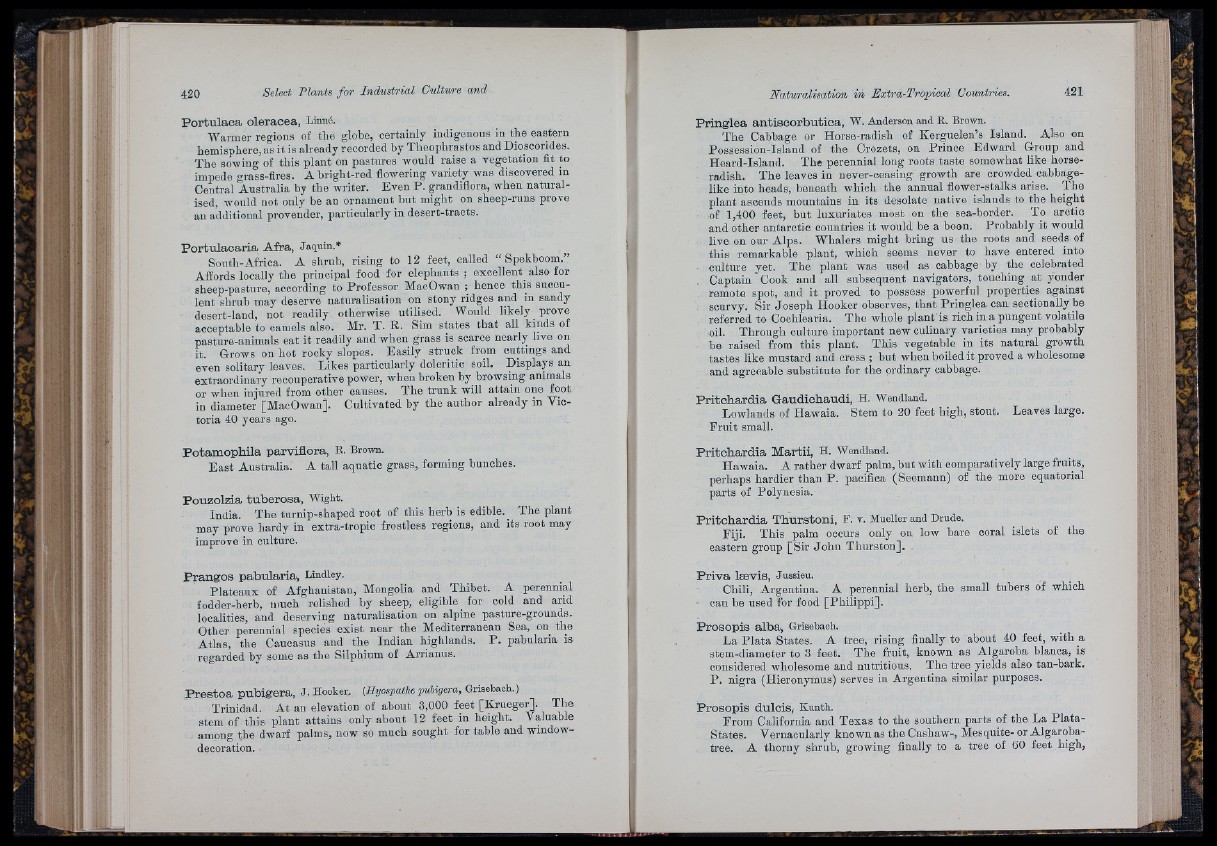
Portulaoa olerácea, Linné.
Warmer regions of the globe, certainly indigenous in the eastern
hemisphere, as it is already recorded by Theophrastos and Dioscorides.
The sowing of this plant on pastures would raise a vegetation fit to
impede grass-fires. A bright-red flowering variety was discovered in
Central Australia by the writer. Even P. grandiflora, when naturalised,
would not only be an ornament but might on sheep-runs prove
an additional provender, partioularly in desert-tracts.
Portulaoaria Afra, Jaquin.*
South-Africa. A shrub, rising to 12 feet, called “ Spekboom.”
Affords locally the principal food for elephants ; excellent^ also for
sheep-pasture, according to Professor MacOwan ; hence this succulent
shrub may deserve naturalisation on stony ridges and in sandy
desert-land, not readily otherwise utilised. Would likely prove
acceptable to camels also. Mr. T. R. Sim states th a t all kinds of
pasture-animals eat it readily and when grass is scarce nearly live on
it. Grows on hot rocky slopes. Easily struck from cuttings and
even solitary leaves. Likes particularly doleritic soil. Displays an
extraordinary reconperative power, when broken by browsing animals
or when injured from other causes. The trunk will attain one foot
in diameter [MacOwan]. Cultivated by the author already in Victoria
40 years ago.
Potamophila parviflora, B- Brown.
E a st Australia. A tall aquatic grass, forming hunches.
Pouzolzia tuberosa, Wight.
India. The turnip-shaped root of this herb is edible. _ The plant
may prove hardy in extra-tropic frostless regions, and its root may
improve in culture.
P r a n g o s p a b u la r ia , Lindley.
Plateaux of Afghanistan, Mongolia and Thibet. A perennial
fodder-herb, much relished by sheep, eligible for cold and arid
localities, and deserving naturalisation on alpine pasture-grounds.
Other perennial species exist near the Mediterranean Sea, on the
Atlas, the Caucasus and the Indian highlands. P . pabularia is
regarded by some as the Silphium of Arrianus.
Prestoa pubigera, J. Hooker. (Hyospathe puUgera, Grkehach.)
Trinidad. A t an elevation of about 3,000 feet [Krueger]. The
stem of tbis plant attains only about 12 feet in height. VMuable
among the dwarf palms, now so much sought for table and wmdow-
deooration.
Pringlea antiscorbutica, w. Anderson and R. Brown.
The Cabbage or Horse-radish of Kerguelen’s Island. Also on
Possession-Island of the Crozets, on Priuce Edward Group and
Heard-Island. The perennial long roots taste somewhat like horseradish.
The leaves in never-ceasing growth are crowded cabbagelike
into heads, beneath which the annual flower-stalks arise. The
plant ascends mountains in its desolate native islands to the height
of 1,400 feet, but luxuriates most on the sea-border. Tp arctic
and other antarctic countries it would be a boon. Probably it would
live on our Alps. Whalers might bring us the roots and seeds of
this remarkable plant, which seems never to have entered into
culture yet. The plant was used as cabbage by the celebrated
, Captain Cook and all subsequent navigators, touching at yonder
remote spot, and it proved to possess powerful properties against
scurvy. Sir Joseph Hooker observes, th a t Pringlea can sectionally be
referred to Coclilearia. The whole plant' is rich in a pungent volatile
oil. Through culture important new culinary varieties may probably
be raised from this plant. This vegetable in its natural growth
tastes like mustard and cress ; but when boiled it proved a wholesome
and agreeable substitute for the ordinary cabbage.
Pritchardia Gaudiohaudi, H. Wendland.
Lowlands of Hawaia. Stem to 20 feet high, stout. Leaves large.
F ru it small.
Pritchardia Martii, H. Wendland.
Hawaia. A rather dwarf palm, bnt w ith comparatively large fruits,
perhaps hardier than P . pacifica (Seemann) of the more equatorial
parts of Polynesia.
Pritchardia Thurstoni, F. v. Mueller and Drude.
Fiji. This palm occurs only on low bare coral islets of the
eastern group [Sir Jo h n Thurston].
Priva Isevis, Jussieu.
Chili, Argentina. A perennial herb, the small tubers of which
can be used for food [Philippi].
Prosopis alba, Grisebach.
La P la ta States. A tree, rising finally to about 40 feet, with a
stem-diameter to 3 feet. The fruit, known as Algaroba blanca, is
considered wholesome and nutritious. The tree yields also tan-bark.
P. nigra (Hieronymus) serves in Argentina similar purposes.
Prosopis dulcis, Kunth.
From California and Texas to the southern parts of the La Plata-
States. Vernaoularly known as the Cashaw-, Mesquite- or Algaroba-
tree. A thorny shrub, growing Anally to a tree of 60 feet high,